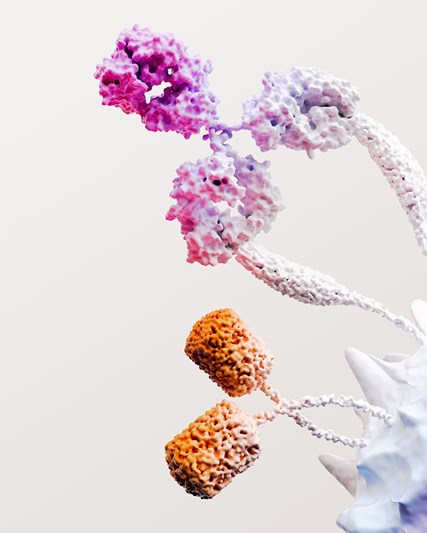Issued: London, UK
For media and investors only
GSK regulatory submission for momelotinib for the treatment of myelofibrosis accepted for review by Japanese regulator
- Regulatory submission included data from pivotal trials addressing key clinical manifestations of myelofibrosis, namely splenomegaly, constitutional symptoms and anaemia
GSK plc (LSE/NYSE: GSK) today announced that the Ministry of Health, Labour and Welfare (MHLW), Japan, has accepted for review a new drug application (NDA) for momelotinib, a potential new medicine with a differentiated mechanism of action that may address the significant medical needs of myelofibrosis patients, especially those with anaemia. The NDA is based on data from the pivotal phase III trials SIMPLIFY-1 and MOMENTUM.
Myelofibrosis is a blood cancer that can lead to splenomegaly (enlarged spleen); constitutional symptoms such as fatigue, night sweats, and bone pain; and severely low blood counts, including anaemia and thrombocytopenia.[1],[2],[3] About 70% of patients diagnosed with primary myelofibrosis and about half of patients diagnosed with secondary myelofibrosis in Japan have moderate to severe anaemia at the time of diagnosis, and nearly all patients are estimated to develop anaemia over the course of the disease.[4],[5],[6],[7],[8],[9] Patients who are transfusion dependent have a poor prognosis and shortened survival.[10],[11],[12],[13],[14],[15],[16],[17],[18]
Momelotinib is not currently approved in any market.
About momelotinib
Momelotinib has a differentiated mechanism of action, with inhibitory ability along three key signalling pathways: Janus kinase (JAK) 1, JAK2, and activin A receptor, type I (ACVR1).[19],[20],[21],[22] Inhibition of JAK1 and JAK2 may improve constitutional symptoms and splenomegaly.[19],[21],[22] Additionally, inhibition of ACVR1 leads to a decrease in circulating hepcidin, which is elevated in myelofibrosis and contributes to anaemia.[19],[20],[21],[22]
About myelofibrosis
Myelofibrosis is a rare blood cancer that disrupts the body’s normal production of blood cells as a result of dysregulated JAK-signal transducer and activator of transcription protein signalling. The clinical hallmarks of myelofibrosis are progressive splenomegaly (enlarged spleen), anaemia and debilitating symptoms attributable to ineffective hematopoiesis and excessive production of proinflammatory cytokines.[23] Myelofibrosis patients with anaemia require additional supportive care, including transfusions, and have poor outcomes.[24],[25] Myelofibrosis affects approximately 1 in 500,000 people worldwide, with up to 5,000 patients impacted in Japan.[10],[19],[26],[27]
About the pivotal SIMPLIFY-1 clinical trial
SIMPLIFY-1 was a multicentre randomised, double-blind, phase III study that compared the safety and efficacy of momelotinib to ruxolitinib in patients with myelofibrosis who had not received prior treatment with a JAK inhibitor. SIMPLIFY-1 met its primary endpoint, demonstrating non-inferiority of momelotinib to ruxolitinib in spleen volume response (reduction by 35% or greater), and substantial improvements in transfusion independence rates.[28],[29]
About the pivotal MOMENTUM clinical trial
MOMENTUM was a global, randomised, double-blind phase III clinical trial of momelotinib (MMB) versus danazol (DAN) in patients with myelofibrosis who were symptomatic and anaemic and had been previously treated with an approved JAK inhibitor. The MOMENTUM trial met all its primary and key secondary endpoints, with respect to splenic response, constitutional symptoms and transfusion independence. Results from the 24-week treatment period were presented at the 2022 American Society of Clinical Oncology (ASCO) Annual Meeting and subsequently published in The Lancet.[22] ,[30]
GSK in oncology
GSK is committed to maximising patient survival through transformational medicines, with a current focus on breakthroughs in immuno-oncology and tumour-cell targeting therapies, and development in haematologic malignancies, gynaecologic cancers and other solid tumours.
About GSK
GSK is a global biopharma company with a purpose to unite science, technology, and talent to get ahead of disease together. Find out more at gsk.com.
- [1] NIH National Library of Medicine. Primary Myelofibrosis. September 2014. Accessed 5 August 2022. https://medlineplus.gov/genetics/condition/primary-myelofibrosis/
- [2] MPN Research Foundation. Primary Myelofibrosis (PMF). 2021. Accessed August 2022. http://www.mpnresearchfoundation.org/primary-myelofibrosis-pmf/
- [3] National Organization for Rare Disorders (NORD). Primary Myelofibrosis. 2018. Accessed 9 August 2022. https://rarediseases.org/rare-diseases/primary-myelofibrosis/
- [4] Takenaka K et al., Clinical features and outcomes of patients with primary myelofibrosis in Japan: report of a 17-year nationwide survey by the Idiopathic Disorders of Hematopoietic Organs Research Committee of Japan. Int J Hematol. 2017 Jan;105(1):59-69. doi: 10.1007/s12185-016-2102-3
- [5] Tefferi A, Lasho TL, Jimma T, et al. One thousand patients with primary myelofibrosis: the mayo clinic experience. Mayo Clin Proc. 2012;87(1):25-33. doi:10.1016/j.mayocp.2011.11.001
- [6] Bose P, et al. Curr Hematol Malign Rep. 2018;13:164-172. doi: https://doi.org/10.3109/10428194.2013.813500
- [7] Scherber, R.M., Mesa, R. Management of challenging myelofibrosis after JAK inhibitor failure and/or progression. Blood Rev. 2020;42:100716. https://doi.org/10.1016/j.blre.2020.100716
- [8] Bassiony S, Harrison CN, McLornan DP. Evaluating the Safety, Efficacy, and Therapeutic Potential of Momelotinib in the Treatment of Intermediate/High-Risk Myelofibrosis: Evidence to Date. Ther Clin Risk Manag. 2020;16:889-901. Published 2020 Sep 25. doi:10.2147/TCRM.S258704
- [9] Shide K et al. Nationwide prospective survey of secondary myelofibrosis in Japan: superiority of DIPSS-plus to MYSEC-PM as a survival risk model. Blood Cancer J. 2023;13(1):110. doi: 10.1038/s41408-023-00869-9
- [10] Naymagon, L., Mascarenhas, J. Myelofibrosis-Related Anemia: Current and Emerging Therapeutic Strategies. HemaSphere. 2017;1(1):e1. doi: 10.1097/HS9.0000000000000001
- [11] How J, Hobbs GS. A Practical Guide for Using Myelofibrosis Prognostic Models in the Clinic. J Natl Compr Canc Netw. 2020;18(9):1271-1278. https://doi.org/10.6004/jnccn.2020.7557
- [12] Nicolosi M, et al. Sex and degree of severity influence the prognostic impact of anemia in primary myelofibrosis: analysis based on 1109 consecutive patients. Leukemia. 2018;32(5):1254-1258. https://doi.org/10.1038/s41375-018-0028-x
- [13] Tefferi A, et al. Use of the Functional Assessment of Cancer Therapy--anemia in persons with myeloproliferative neoplasm-associated myelofibrosis and anemia. Clin Ther. 2014;36(4):560-566. https://doi.org/10.1016/j.clinthera.2014.02.016
- [14] Tefferi A. Primary myelofibrosis: 2021 update on diagnosis, risk-stratification and management. Am J Hematol. 2021;96(1):145-162. https://doi.org/10.1002/ajh.26050
- [15] Rumi E, et al. The Genetic Basis of Primary Myelofibrosis and Its Clinical Relevance. Int J Mol Sci. 2020;21(23):8885. https://doi.org/10.3390/ijms21238885
- [16] QxMD. DIPSS prognosis in myelofibrosis. Accessed September 12, 2022. https://qxmd.com/calculate/calculator_187/dipss-prognosis-in-myelofibrosis.
- [17] QxMD. DIPSS plus score for prognosis of myelofibrosis. Accessed September 12, 2022.
- [18] Elena C, et al. Red blood cell transfusion-dependency implies a poor survival in primary myelofibrosis irrespective of IPSS and DIPSS. Haematologica. 2011;96(1):167-170. https://doi.org/10.3324/haematol.2010.031831
- [19] Chifotides, HT, Bose, P, Verstovsek, S. Momelotinib: an emerging treatment for myelofibrosis patients with anemia. J Hematol Oncol. 2022;15(7):1-18.
- [20] Asshoff M, et al. Momelotinib inhibits ACVR1/ALK2, decreases hepcidin production, and ameliorates anemia of chronic disease in rodents. Blood. 2017;129(13):1823-1830.
- [21] Oh S, et al. ACVR1/JAK1/JAK2 inhibitor momelotinib reverses transfusion dependency and suppresses hepcidin in myelofibrosis phase 2 trial. Blood Adv. 2020;4(18):4282-4291.
- [22] Verstovsek S, et al. Momelotinib versus danazol in symptomatic patients with anaemia and myelofibrosis (MOMENTUM): results from an international, double-blind, randomised, controlled, phase 3 study. The Lancet. 2023;401(10373):269-280.
- [23] Atallah E, Verstovsek S. Emerging drugs for myelofibrosis. Expert Opin Emerg Drugs. 2012 Dec;17(4):555-70. doi: 10.1517/14728214.2012.748748. PMID: 23186315; PMCID: PMC5009610.
- [24] Chifotides, H.T., Bose, P. & Verstovsek, S. Momelotinib: an emerging treatment for myelofibrosis patients with anemia. J Hematol Oncol 15, 7 (2022). https://doi.org/10.1186/s13045-021-01157-4
- [25] Naymagon L, Mascarenhas J. Myelofibrosis-Related Anemia: Current and Emerging Therapeutic Strategies. Hemasphere. 2017 Dec 20;1(1):e1. doi: 10.1097/HS9.0000000000000001. PMID: 31723730; PMCID: PMC6745971.
- [26] Data on file. Sierra Oncology. 2021.
- [27] Myelofibrosis – Epidemiology Forecast – 2032. DelveInsight. 2022;1-60.
- [28] Mesa R, et al. Presented at: ISPOR 2021.
- [29] Mesa R, et al. Presented at: SOHO 2021. Poster MPN-303.
- [30] Mesa R, et al. Presented at: American Society of Clinical Oncology; June 2022. Abstract 7002.



